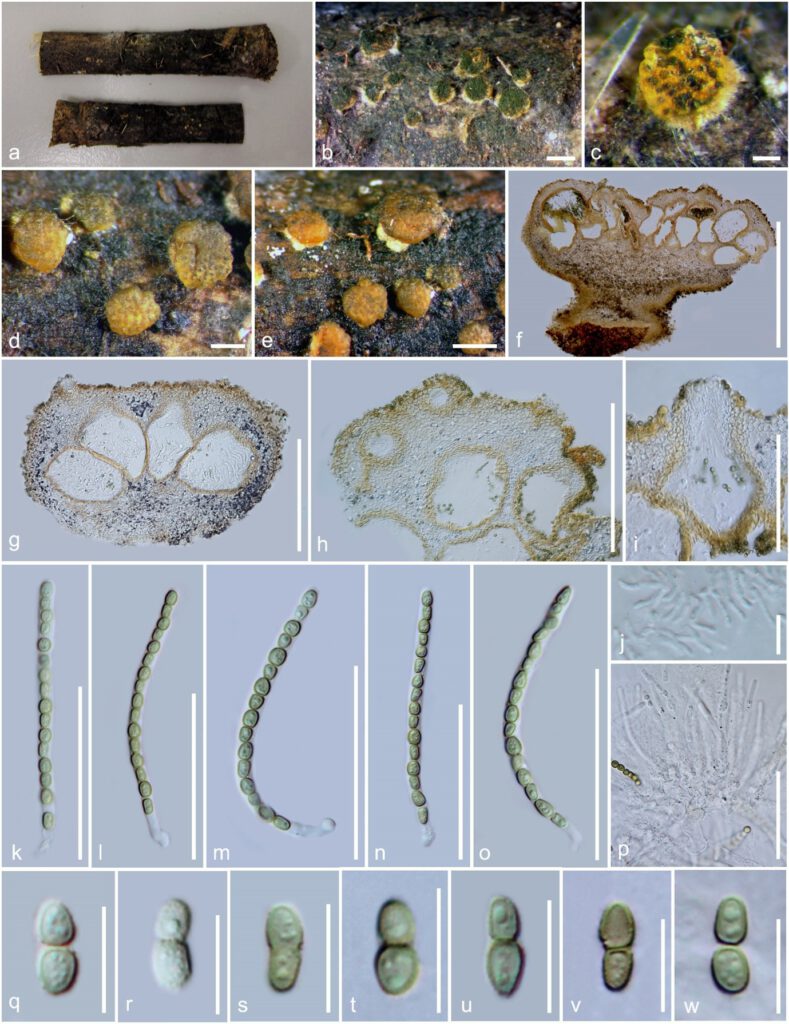Trichoderma bambusicola R.H. Perera, Maharachch. & K.D. Hyde, sp. nov.
MycoBank number: MB 559631; Index Fungorum number: IF 559631; Facesoffungi number: FoF 10971;
Etymology: Refers to the host which the fungus inhabits
Saprobic on decaying stem of a bamboo plant. Sexual morph: Stromata 0.5–1.5 mm diam., discrete or gregarious, superficial, discoid, slightly stipitate, without a true cortex, composed of pseudoparenchyma cells, yellow-orange or brownish orange, KOH-, ascomatal elevations distinctly prominent, stromatal surface smooth, variously wrinkled, without hairs, ostioles appearing as hyaline or brown spots on stroma surface. Ascomata 140–190 µm high × 100–170 µm diam., numerous, immersed in stromatal tissue, perithecial, globose to ellipsoidal, brownish orange, ostiolate. Ostiolar canal lined with septate, hyaline periphyses. Peridium 6–25 µm wide, wider around the ostiolar neck, of single stratum, consisting of pigmented, thin-walled, compressed, angular cells; pseudoparenchymatous in ostiolar region, integrating with the surrounding tissue, brownish orange. Asci 68–86 µm × 3.7–5 µm (x̄ = 78.3 × 4.4 µm), 8-spored, unitunicate, long cylindrical, short stipitate, with a knob-like base, with a minute apical pore, J-, lying without paraphyses. Ascospores 7.6–9.3 µm × 3–4µm (x̄ = 8.5 × 3.4 µm), uniseriate, bicellular, disarticulating into two unequal part ascospores: upper part subglobose to oval or slightly tapered towards the upper end; lower part oblong or wedge-shaped; guttulate, green, verrucose. Asexual morph: Undetermined.
Material examined: THAILAND, Phyao Province, on fallen decaying stem of a bamboo, 04 August 2017, R.H. Perera, PH09 (MFLU 18-2747, holotype).
GenBank numbers: ITS: ON230047, LSU: ON230055, rpb1: ON238007, tef1: ON238001, tub2: ON238008.
Notes: Our collection MFLU 18-2747 belongs to the Trichoderma harzianum species complex and is phylogenetically related to the ex-type of Trichoderma velutinum (C.P.K. 298) with high statistical support (94% MLBT) (Bissett et al. 2003). DNA sequences of MFLU 18-2747 and T velutinum (C.P.K. 298) differ in 53 nucleotides of the ITS region (10.8%, 22 gaps) and 14 nucleotides of the tef1 region (3%, 5 gaps). Cai & Druzhinina (2021) observed that ITS is polymorphic in the harzianum group. Therefore, they suggested to delineate species in harzianum group based on tef1 and rpb2 sequences. However, no rpb2 data are available for the ex-type of T. velutinum in the GenBank. Neocleotide similarity of the tef1 region of our collection and ex-type of T. velutinum is 97%; which leads to identify our collection as T. velutinum (Cai & Druzhinina (2021). However, an asexual morph has only been reported for T. velutinum to date (Bissett et al. 2003) and, our collection is a sexual morph taxon. Considering the highly different ITS region and unavailability of morphological comparisons we introduce our collection as a new species T. bambusicola. We could not maintain the living cultures of this fungus therefore, DNA was extracted directly from the fruiting bodies.

Fig. x Trichoderma bambusicola (MFLU 18-2747, holotype) a Herbarium material with b–e Stromata on host substrate f–i Vertical section of stromata and ascomata j–o Asci p–v Ascospores (v part calls separated from each other. Scale bars: b = 1000 µm, c = 200 µm, d = 500 µm, e = 1000 µm, f = 500 µm, g, h = 200 µm, i = 100, j = 10 µm, k–p = 5 µm, q–w = 10 µm.
